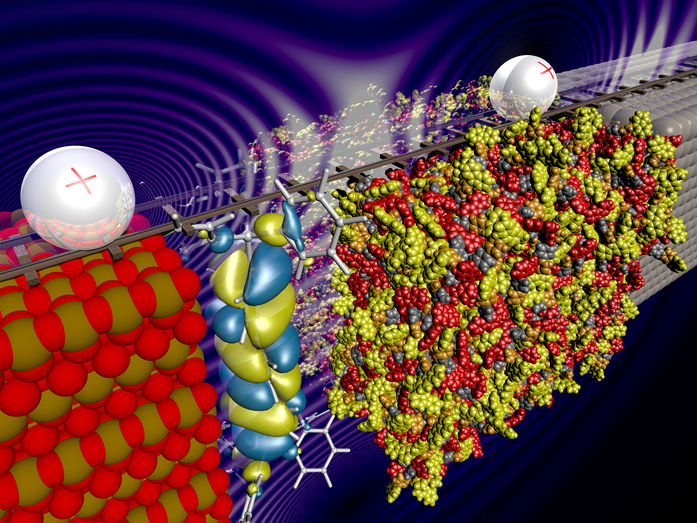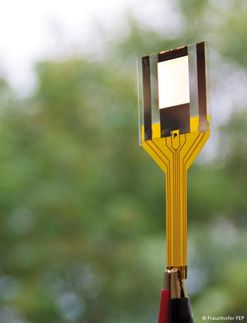OLED: Nanometer-thin layer improves efficiency
Scientists at the Max Planck Institute for Polymer Research in Mainz, Germany, have received an unexpected result: They have discovered a new method to improve contacts in OLEDs. This new approach leads to a higher energy efficiency and can be used in almost any organic semiconductor element.

Visualization of a current through an OLED, flowing via a thin molecular layer (center) from an electrode (left) to an organic semiconductor (right).
© Max Planck Institute for Polymer Research
Organic light-emitting diodes (OLEDs) are used as light sources in high-quality smartphone displays and large-area high-end products such as OLED televisions. The main active component in an OLED is a light-emitting layer of an organic semiconductor, which converts electrical energy into visible light. In an OLED, the organic semiconducting layer is situated between two electrodes; by applying a voltage across these two electrodes, an electric current passes through the OLED, which is converted into visible light.
However, for many organic semiconductors, especially for blue- or ultraviolet-emitting materials, it is difficult to inject the current from the positive electrode into the OLED. This leads to low efficiencies in OLEDs.
Dr. Gert-Jan Wetzelaer, Group Leader at the Max Planck Institute for Polymer Research in Mainz, Germany, has recently discovered a way of improving the current injection from the positive electrode in OLEDs. Wetzelaer and his team have covered the positive electrode with an ultrathin layer of another organic semiconductor as a spacer layer between the electrode and the light-emitting organic semiconductor. Wetzelaer said: “The result was unexpected. This nanometer-thin layer facilitates charge transfer between the electrode and the organic semiconductor. Although it seems to be illogical at first, eliminating physical contact between electrode and semiconductor actually improves the electrical contact.”
Improved contacts in semiconductors
Improving electrical contact with an ultrathin interlayer greatly increases the efficiency of ultraviolet-emitting OLEDs. The scientists at the MPI for Polymer Research have demonstrated this improvement of electrodes for a large number of organic semiconductors and for different spacer layers. Professor Paul Blom, Director at the Max Planck Institute for Polymer Research and head of its Molecular Electronics Department, is convinced: “This simple method of covering electrodes in OLEDs with an ultrathin layer for current-injection improvement is a resounding success for technical application in high-end electronics.”
Gert-Jan Wetzelaer and his research team are very confident that this new approach for fabricating improved contacts can be used in basically any organic-semiconductor device, which could boost their performance now.
Original publication
Other news from the department science

Get the chemical industry in your inbox
By submitting this form you agree that LUMITOS AG will send you the newsletter(s) selected above by email. Your data will not be passed on to third parties. Your data will be stored and processed in accordance with our data protection regulations. LUMITOS may contact you by email for the purpose of advertising or market and opinion surveys. You can revoke your consent at any time without giving reasons to LUMITOS AG, Ernst-Augustin-Str. 2, 12489 Berlin, Germany or by e-mail at revoke@lumitos.com with effect for the future. In addition, each email contains a link to unsubscribe from the corresponding newsletter.



























































